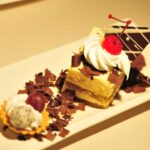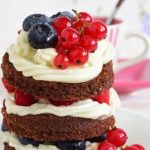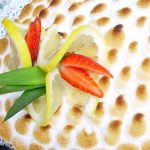Are you looking to enhance your cake decorating skills? Learn how to decorate cake with chocolate ganache and take your creations to the next level.
Chocolate ganache has become a favorite among bakers and pastry chefs due to its rich and indulgent flavor, as well as its versatility in creating stunning cake decorations. In this article, we will explore the various techniques and tips for using chocolate ganache to decorate cakes, from preparing the ganache from scratch to applying it onto the cake in sophisticated designs.
Chocolate ganache comes in different forms, such as dark, milk, and white chocolate varieties, each offering a unique taste and texture. Understanding the types of chocolate ganache available will allow you to choose the best option for your specific cake decorating needs. Whether you’re aiming for a bold and intense flavor with dark chocolate or a sweeter touch with milk or white chocolate, there’s a ganache type that will suit your preferences.
Additionally, we will provide you with a step-by-step guide on how to prepare chocolate ganache from scratch. This includes essential ingredients and proper techniques for achieving that velvety smooth consistency that is perfect for cake decoration. By mastering the art of making chocolate ganache at home, you can have full control over its quality and customize it according to your desired flavor profile.
Stay tuned as we delve into choosing the right cake base for decorating with chocolate ganache, applying the ganache onto the cake, exploring various decorating techniques, expert tips and tricks for troubleshooting any issues that may arise, as well as showcasing creative inspiration for using chocolate ganache in cake decorations. Get ready to elevate your baking skills and create stunning cakes with our comprehensive guide on using chocolate ganache for decoration.
Types of Chocolate Ganache
When it comes to decorating cakes with chocolate ganache, the type of chocolate used can significantly impact the flavor and appearance of the final product. There are several variations of chocolate ganache, each offering a unique taste and texture that can be tailored to suit different cake styles and personal preferences.
Dark Chocolate Ganache
Dark chocolate ganache is made with a higher percentage of cocoa solids, resulting in a rich and intense chocolatey flavor. It is a popular choice for those who enjoy the deep, bittersweet taste of dark chocolate. Dark chocolate ganache also has a thicker consistency compared to other types, making it suitable for creating sharp edges and intricate designs when decorating cakes.
Milk Chocolate Ganache
Milk chocolate ganache has a milder flavor profile due to the addition of milk solids. This type of ganache offers a creamy and smooth texture, making it an ideal choice for pairing with lighter cake flavors such as vanilla or fruit-infused cakes. Milk chocolate ganache is versatile and can be used for both filling layers and outer cake coatings.
White Chocolate Ganache
White chocolate ganache is known for its sweet and buttery taste, which pairs well with various types of cakes. Unlike dark and milk chocolate ganache, white chocolate ganache does not contain cocoa solids, resulting in a pale color and delicate flavor profile. It is often used as a decorative element for contrast on darker-colored cakes or as a base for vibrant food coloring to create visually striking designs.
Understanding the distinct characteristics of each type of chocolate ganache is essential when selecting the best option for decorating your cake. Whether you prefer the boldness of dark chocolate, the creaminess of milk chocolate, or the sweetness of white chocolate, there is a perfect ganache variation to elevate any cake creation.
Preparing Chocolate Ganache
Chocolate ganache is a versatile and delicious option for decorating cakes, providing a rich and luxurious finish that can elevate any dessert. Making chocolate ganache from scratch may seem intimidating, but with the right ingredients and techniques, it can be a simple and rewarding process.
To prepare chocolate ganache, you will need high-quality chocolate (either dark, milk, or white), heavy cream, and optional flavorings such as vanilla extract or liqueur. The ratio of chocolate to cream will depend on the desired consistency of the ganache, whether for spreading, filling, or glazing. For a thicker ganache suitable for piping and creating textured designs on the cake, a higher proportion of chocolate to cream is recommended.
The first step in making chocolate ganache is chopping the chocolate into small pieces to ensure even melting. Next, heat the heavy cream in a saucepan until it just begins to simmer, then pour it over the chopped chocolate. Allow the mixture to sit for a few minutes before stirring gently to combine the ingredients into a smooth and glossy ganache.
Adding flavorings at this stage will infuse the ganache with additional depth and complexity. Once prepared, the ganache should be allowed to cool slightly before using it to decorate cakes.
| Ingredients | Ratio |
|---|---|
| High-quality Chocolate | 1:1 for thick ganache; 2:1 for pouring ganache |
| Heavy Cream | Varies based on desired consistency |
| Flavorings (Optional) | To taste |
Choosing the Right Cake
When it comes to decorating cakes with chocolate ganache, choosing the right cake base is essential for creating a delicious and visually appealing dessert. The type of cake you select can greatly influence the overall taste and texture of the final product when paired with chocolate ganache. Here are some tips on selecting the best cake base for decorating with chocolate ganache:
- Consider flavor pairing: When choosing a cake for chocolate ganache decoration, it’s important to consider flavor pairing. For dark chocolate ganache, rich and bold flavors such as devil’s food or red velvet cakes work well. For milk or white chocolate ganache, lighter flavors like vanilla or coconut can complement the sweetness of the ganache.
- Take texture into account: The texture of the cake also plays a significant role in how well it pairs with chocolate ganache. Moist and dense cakes, such as pound cake or chocolate fudge cake, provide a solid base for applying and holding the ganache without becoming soggy. On the other hand, light and airy cakes like sponge or chiffon can create a delicate contrast with the rich ganache.
- Consider filling options: If you plan to use filling in your cake, it’s important to choose one that complements both the cake and chocolate ganache. Filling options such as fruit preserves, caramel, or creamy frosting can add layers of flavor and texture that enhance the overall dessert.
By carefully considering these factors when selecting a cake base for decorating with chocolate ganache, you can ensure that your final creation not only looks stunning but also delivers a delightful culinary experience for those enjoying it. Whether it’s a simple birthday cake or an elaborate celebration masterpiece, choosing the right cake is an essential step in creating an unforgettable dessert.
Applying Chocolate Ganache
Spreading the Ganache
To start, ensure that your cake is properly leveled and chilled before applying the ganache. Using a palette knife or an offset spatula, spread the ganache evenly over the top of the cake, allowing it to flow naturally over the edges. Work quickly but carefully to avoid any uneven patches or air bubbles in the ganache.
Smoothing Techniques
Once the ganache is spread on the cake, there are several techniques for achieving a smooth finish. One method is using a bench scraper held perpendicular to the cake’s surface, gently run it around the sides to create a sleek and even coating. Another technique involves dipping an offset spatula in hot water, drying it off, then using it to smooth out any imperfections in the ganache.
Creating Textured Designs
For those looking to add visual interest to their cake, consider experimenting with textured designs using chocolate ganache. This can be achieved by using different tools such as combs, icing scrapers, or even simple kitchen utensils like forks to create swirls, waves, or patterns in the ganache. Additionally, you can also create decorative shapes or motifs by piping additional layers of ganache onto the smoothed surface.
By following these detailed instructions for applying chocolate ganache to your cake, you can achieve professional-looking results that are sure to impress your guests with both their taste and appearance.
Decorating Techniques
Decorating a cake with chocolate ganache opens up a world of creative possibilities. There are numerous techniques that can be used to elevate the appearance of the cake and make it visually appealing. Whether you’re looking to create intricate designs or add a simple yet elegant touch, mastering various decorating techniques is essential for achieving stunning results. Here are some popular methods for decorating cakes with chocolate ganache:
- Piping: Piping chocolate ganache onto a cake allows you to create intricate patterns, floral designs, or written messages. Using a piping bag fitted with a decorative tip, you can add beautiful details to your cake that are sure to impress your guests.
- Drizzling: Drizzling chocolate ganache over the top of a cake creates a gorgeous and appetizing finish. This technique adds an extra layer of decadence and can be used to give the cake a professional bakery-style look.
- Creating Chocolate Ganache Drip Effects: Adding drip effects to a cake with chocolate ganache is a trendy and eye-catching decoration technique. By carefully pouring slightly warmed ganache around the edges of the cake, you can achieve a stunning cascading drip effect that instantly enhances the overall appeal of the dessert.
Experimenting with these techniques will allow you to customize your cake’s appearance based on your personal style and the theme of the occasion. From elegant swirls and precise lines to playful drips and drizzles, there are endless possibilities for creating visually stunning cakes using chocolate ganache as the main decorative element.
Tips and Tricks
Chocolate ganache is a versatile and decadent ingredient that can elevate the appearance and flavor of any cake. To achieve the perfect chocolate ganache cake decoration, it is important to be mindful of a few expert tips and tricks. One common issue when working with chocolate ganache is achieving the right consistency. If the ganache is too runny, it will not adhere to the cake properly, while if it’s too thick, it will be difficult to spread.
To troubleshoot this problem, be sure to adjust the ratio of chocolate to cream in your ganache. For a thicker consistency, use more chocolate than cream, while for a thinner consistency, increase the amount of cream in your mixture. Additionally, allowing the ganache to cool at room temperature can help thicken the mixture.
Another important tip for achieving the perfect chocolate ganache cake decoration is ensuring that your cake is at the right temperature before applying the ganache. It’s crucial that your cake has cooled completely before spreading the ganache. If you apply it too soon, the heat from the cake will cause the ganache to melt and slide off.
Finally, when using chocolate ganache for decorative piping or other intricate designs, it’s important to work efficiently as it sets relatively quickly. A handy trick is to warm up your piping bag slightly with your hands before filling it with ganache – this will help maintain a smooth and consistent flow when decorating your cake.
| Common Issue | Troubleshooting Tip |
|---|---|
| Consistency too thick or too runny | Adjust chocolate to cream ratio; Allow ganche to cool at room temperature |
| Gananche sliding off cake | Ensure cake has cooled completely before applying gananche |
| Gananche setting quickly for decorating | Warm piping bag slightly with hands before filling with ganchace |
Inspiration and Ideas
In conclusion, chocolate ganache is a versatile and indulgent way to decorate cakes, providing a rich and luxurious finish that will impress any dessert lover. From its ability to be piped into intricate designs to its smooth and shiny texture for drip effects, chocolate ganache offers endless possibilities for cake decoration. By mastering the art of working with chocolate ganache, you can elevate your homemade or professionally baked cakes to a whole new level.
Whether you’re preparing a cake for a special occasion like a birthday, wedding, or anniversary, or simply want to add an elegant touch to your desserts for everyday enjoyment, chocolate ganache can be the perfect choice. Its decadent flavor and glossy appearance make it ideal for creating show-stopping cakes that will leave a lasting impression on your guests.
From simple yet elegant designs to more elaborate and themed decorations, the options for using chocolate ganache are truly endless. Whether you’re looking for inspiration for floral designs, abstract patterns, or even incorporating other flavors and ingredients into your ganache decorations, there’s no limit to the creativity you can achieve with this delicious cake decorating technique. With the right techniques and a bit of imagination, chocolate ganache can truly transform any ordinary cake into a stunning masterpiece.
Frequently Asked Questions
Should Ganache Cool Before Pouring on Cake?
Ganache should be cooled before pouring it on a cake. If the ganache is too hot, it will melt the buttercream or frosting on the cake, resulting in a messy finish. Allowing the ganache to cool slightly will help to create a smooth and even layer over the cake.
How Do You Frost a Cake With Ganache?
Frosting a cake with ganache involves first allowing the ganache to cool to a spreadable consistency. Once it has thickened but is still spreadable, using an offset spatula or palette knife can help achieve an even layer of ganache over the cake. Starting from the top and working outward and downward can help to create a clean and professional finish.
What Consistency Should Ganache Be to Cover a Cake?
The consistency of ganache used to cover a cake should be thick but still pourable. It should be able to coat the back of a spoon without being too runny, but also have enough fluidity to spread evenly across the surface of the cake.
Achieving this balance of thickness and spreadability will result in a beautiful and glossy presentation for the finished cake.

Welcome to my blog about home and family. This blog is a place where I will share my thoughts, ideas, and experiences related to these important topics. I am a stay-at-home mom with two young children. I hope you enjoy reading it! and may find some helpful tips and ideas that will make your home and family life even better!





